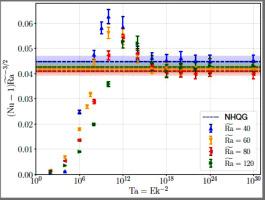快速旋转对流的良好条件直接数值模拟的重标化方程
IF 3.8
2区 物理与天体物理
Q2 COMPUTER SCIENCE, INTERDISCIPLINARY APPLICATIONS
引用次数: 0
摘要
对流是驱动地球物理/天体物理流体流动的普遍过程,通常在大尺度上受到行星旋转的强烈约束。这种流动的一个著名模型,快速旋转的瑞利-巴姆纳德对流,已经在直接数值模拟(DNS)和实验室实验中得到了广泛的研究,但是通过最先进的方法可以获得的参数值仅限于中等快速的旋转(Ekman数Ek > 10−8),而现实的地球物理/天体物理Ek要小得多。渐近化简运动方程,即描述极限Ek→0时流动演化的非流体静力类地转方程(NHQGE),在有限旋转速率下不适用。因此,小而有限的Ek的地球物理/天体物理状态目前仍然无法获得。在这里,我们引入了一种新的,数值上有利的Navier-Stokes - boussinesq方程的公式,该公式由Ek→0有效的缩放表示,即重标快速旋转不可压缩Navier-Stokes方程(RRRiNSE)。我们使用谱拟逆方法求解RRRiNSE,从而得到一个稀疏、快速的算法,在这个以前无法实现的参数域中执行有效的DNS。我们在Ek范围内验证了我们的结果,并证明所采用的算法方法在Ek低至10−15时仍然准确且数值稳定。与NHQGE一样,RRRiNSE的效率来自于适当的调节,消除了在小Ek时导致数值不稳定的虚假增长模式。我们表明,在足够大的区域内,平均温度的时间导数对于准确确定稳态下的努塞尔数是无关紧要的,这大大减少了所需的模拟时间,并提高了数值公式的稳定性。我们进一步证明了使用RRRiNSE的完整DNS在非常小的Ek上与NHQGE一致。本文章由计算机程序翻译,如有差异,请以英文原文为准。

Rescaled equations for well-conditioned direct numerical simulations of rapidly rotating convection
Convection is a ubiquitous process driving geophysical/astrophysical fluid flows, which are typically strongly constrained by planetary rotation on large scales. A celebrated model of such flows, rapidly rotating Rayleigh–Bénard convection, has been extensively studied in direct numerical simulations (DNS) and laboratory experiments, but the parameter values attainable by state-of-the-art methods are limited to moderately rapid rotation (Ekman numbers ), while realistic geophysical/astrophysical are significantly smaller. Asymptotically reduced equations of motion, the nonhydrostatic quasi-geostrophic equations (NHQGE), describing the flow evolution in the limit , do not apply at finite rotation rates. The geophysical/astrophysical regime of small but finite therefore remains currently inaccessible. Here, we introduce a new, numerically advantageous formulation of the Navier–Stokes–Boussinesq equations informed by the scalings valid for , the Rescaled Rapidly Rotating incompressible Navier–Stokes Equations (RRRiNSE). We solve the RRRiNSE using a spectral quasi-inverse method resulting in a sparse, fast algorithm to perform efficient DNS in this previously unattainable parameter regime. We validate our results against the literature across a range of , and demonstrate that the algorithmic approaches taken remain accurate and numerically stable at as low as . Like the NHQGE, the RRRiNSE derive their efficiency from adequate conditioning, eliminating spurious growing modes that otherwise induce numerical instabilities at small . We show that in sufficiently large domains the time derivative of the mean temperature is inconsequential for accurately determining the Nusselt number in the stationary state, significantly reducing the required simulation time and leading to improved stability of our numerical formulation. We furthermore demonstrate that full DNS using RRRiNSE agree with the NHQGE at very small .
求助全文
通过发布文献求助,成功后即可免费获取论文全文。
去求助
来源期刊

Journal of Computational Physics
物理-计算机:跨学科应用
CiteScore
7.60
自引率
14.60%
发文量
763
审稿时长
5.8 months
期刊介绍:
Journal of Computational Physics thoroughly treats the computational aspects of physical problems, presenting techniques for the numerical solution of mathematical equations arising in all areas of physics. The journal seeks to emphasize methods that cross disciplinary boundaries.
The Journal of Computational Physics also publishes short notes of 4 pages or less (including figures, tables, and references but excluding title pages). Letters to the Editor commenting on articles already published in this Journal will also be considered. Neither notes nor letters should have an abstract.
 求助内容:
求助内容: 应助结果提醒方式:
应助结果提醒方式:


